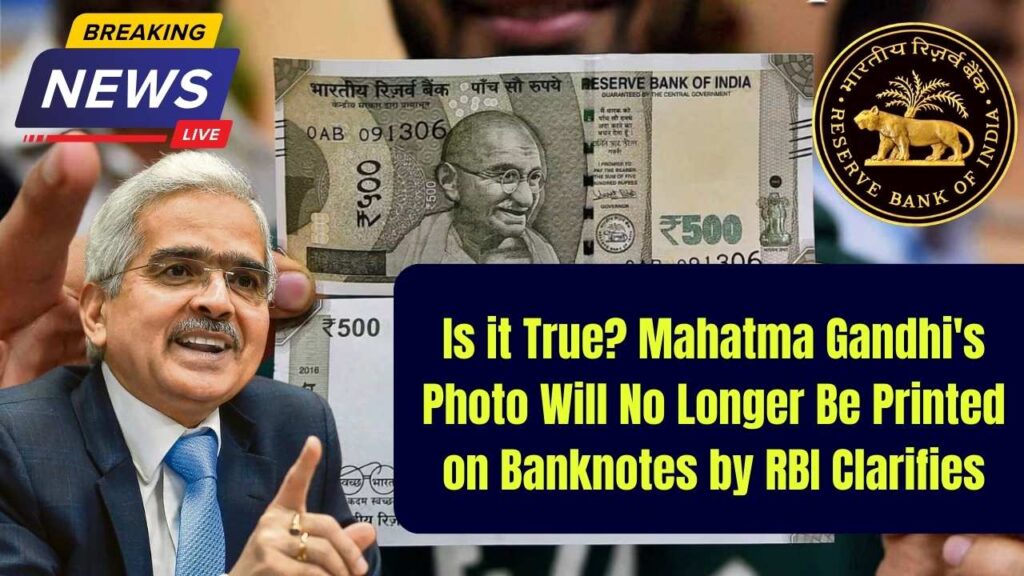India’s central bank, the Reserve Bank of India (RBI), has officially clarified that there are no plans to remove Mahatma Gandhi’s portrait from Indian currency notes. Recent rumors suggesting that RBI might replace the iconic image have been debunked as misinformation.

For decades, Mahatma Gandhi’s portrait has been a symbol of India’s economic and historical identity, and the RBI reassures the public that there is no change in this regard.
Is it True? Mahatma Gandhi’s Photo Will No Longer Be Printed on Banknotes by RBI Clarifies
| Topic | Key Information |
|---|---|
| Official Clarification | RBI confirms no plans to remove Mahatma Gandhi’s image from banknotes. |
| Reason for Concern | Fake news and social media rumors about potential design changes. |
| Historical Significance | Mahatma Gandhi’s image has been on Indian currency since 1996. |
| Future of Indian Banknotes | RBI continues to focus on advanced security features and design updates. |
| Official Source | Reserve Bank of India |
The claim that the RBI will remove Mahatma Gandhi’s image from Indian currency is false. The RBI has confirmed that there are no such plans, and Gandhi’s portrait will continue to feature on banknotes. While discussions about including other historical figures have been ongoing, no official decision has been made.
For the latest updates, always rely on official sources like the RBI and Government of India websites instead of unverified social media reports.
Why Was This Rumor Circulating?
Recently, social media platforms and some news outlets reported that the RBI was considering replacing Mahatma Gandhi’s portrait with other eminent Indian personalities. This led to widespread speculation and concern among the public.
The rumors gained traction due to ongoing discussions about diversity in Indian currency designs and the possibility of featuring other notable Indian leaders. However, the RBI has categorically denied any such changes.
The RBI’s Official Statement
To clear the confusion, an RBI spokesperson confirmed:
“There is no proposal under consideration to replace Mahatma Gandhi’s portrait on Indian currency notes.”
This statement puts to rest all speculations about any drastic changes to India’s banknotes.
History of Mahatma Gandhi on Indian Currency
Mahatma Gandhi’s image first appeared on Indian banknotes in 1996 with the introduction of the Mahatma Gandhi Series. This replaced earlier currency notes that featured images of various historical figures, including British monarchs before independence.
Evolution of Indian Banknotes
- Pre-1947: Indian currency featured British rulers like King George VI.
- 1947-1996: The Ashoka Pillar was the primary symbol on Indian banknotes.
- 1996-Present: Mahatma Gandhi’s image has been a consistent feature on all denominations.
- 2016-Present: The RBI introduced the Mahatma Gandhi (New) Series, featuring new security features and redesigned banknotes.
Why is Mahatma Gandhi’s Image So Important?
Mahatma Gandhi is the Father of the Nation, widely recognized for leading India’s independence movement through non-violent resistance. His philosophy of truth (Satyagraha) and non-violence (Ahimsa) are deeply embedded in India’s history.
By featuring his image on banknotes, the RBI acknowledges:
- National unity and identity
- His role in India’s independence struggle
- International recognition of his principles
How Banknotes Are Designed: The RBI’s Process
The process of designing Indian banknotes is meticulous and involves several layers of research, security enhancements, and expert consultations.
Key Steps in Designing a Banknote
- Proposal & Conceptualization – The RBI, in coordination with the Government of India, decides on changes to currency design.
- Security Features Integration – New features are added to prevent counterfeiting (e.g., watermarks, color-changing ink, micro-texts).
- Printing & Quality Checks – Banknotes are produced at RBI’s currency printing presses with strict quality control measures.
- Distribution – The notes are circulated through banks and ATMs across India.
Future of Indian Currency: Will We See More Leaders on Banknotes?
While the RBI has confirmed that Mahatma Gandhi’s image will remain on banknotes, there has been ongoing debate about featuring other national leaders.
Several eminent personalities, including Dr. B.R. Ambedkar, Sardar Patel, and Subhash Chandra Bose, have been suggested for inclusion. Many believe that showcasing multiple leaders could represent India’s diverse history.
However, any such change would require extensive discussions and approval from the government and RBI.
RBI Penalizes Equitas Small Finance Bank & India Post Payments Bank – Here’s Why!
RBI to Announce Monetary Policy Today – Check Time & Live Streaming Details!
OSSC CHSL Prelims Admit Card 2025 – Download 12th Level exam Admission Call letter at ossc.gov.in
FAQs
1. Has the RBI confirmed the removal of Mahatma Gandhi’s image?
No, the RBI has stated that there are no plans to remove Mahatma Gandhi’s portrait from Indian banknotes.
2. Why is Gandhi’s image on all Indian banknotes?
Mahatma Gandhi represents India’s struggle for independence and is widely recognized as a symbol of peace and non-violence.
3. When did Mahatma Gandhi first appear on Indian currency?
His portrait was introduced in 1996 with the Mahatma Gandhi Series of banknotes.
4. Can the government introduce new figures on currency notes?
Yes, but it requires approval from both the RBI and the Government of India, considering historical, cultural, and security aspects.
5. Where can I find the official RBI statement?
You can visit the Reserve Bank of India’s website for official updates.







